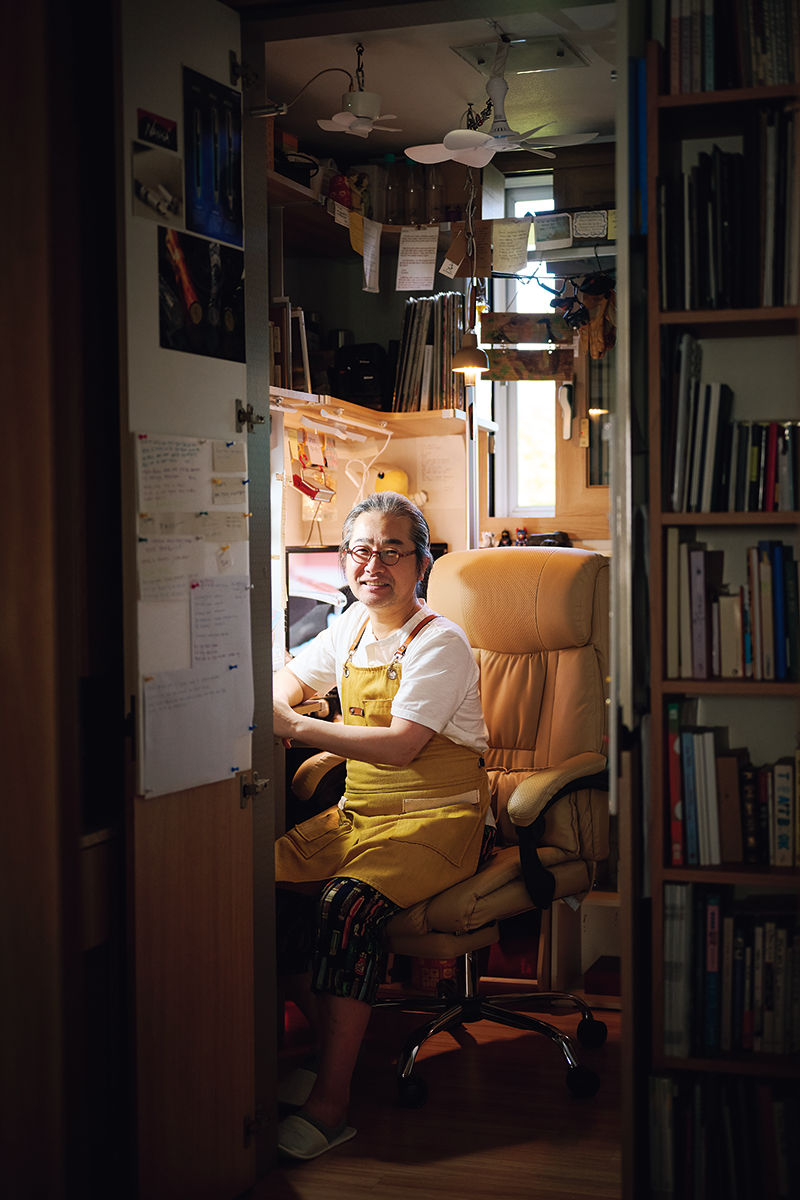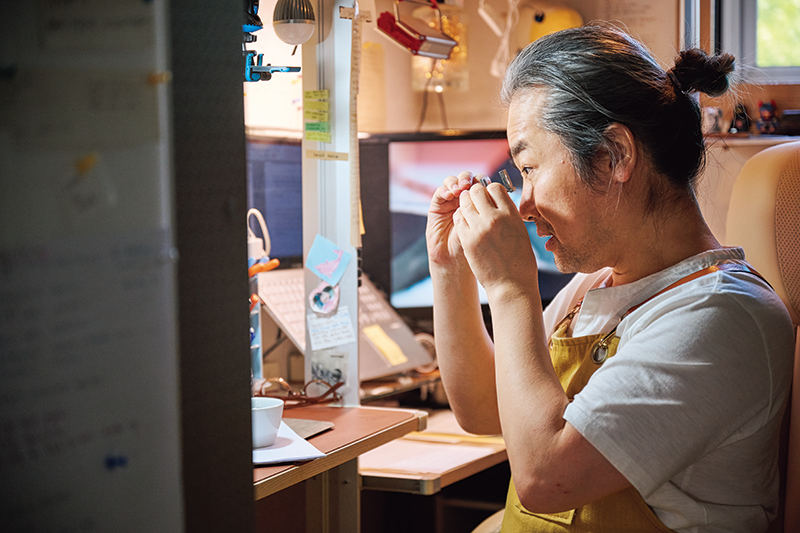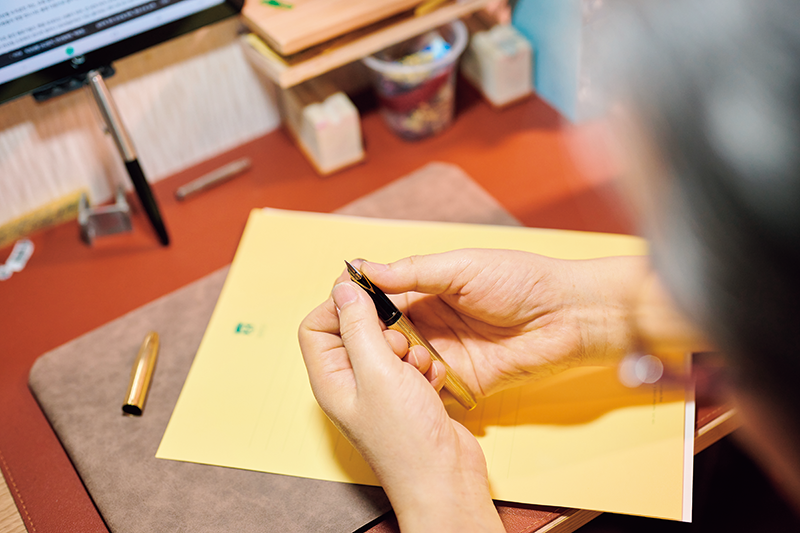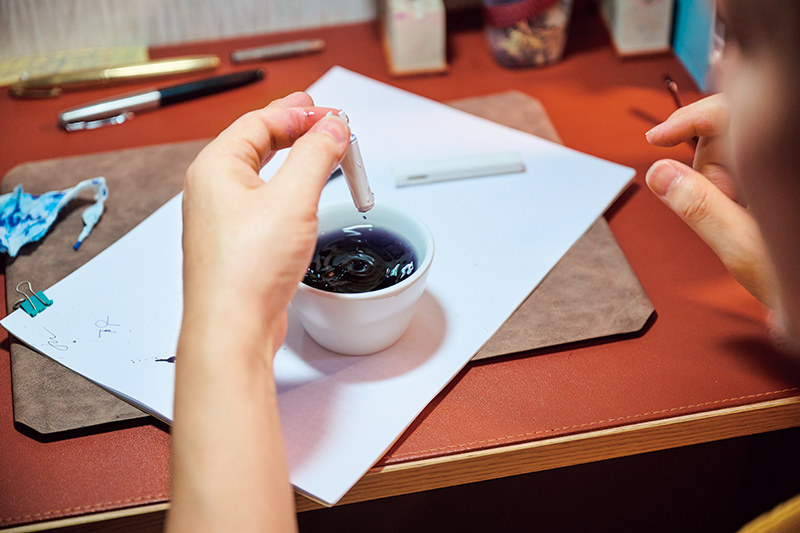In an age that may be labeled “posthandwriting,” some people’s love for fountain pens remains unbroken. For them, a fountain pen represents both a small luxury and a source of joy. If they need a repair, there is one person who takes service to an unparalleled level.

In an age where people rarely write by hand, Kim Deok-rae has made a career out of repairing fountain pens. He says it’s not just about fixing pens; it’s about connecting with people.
When it is Kim Deok-rae’s turn to make breakfast, he arises around seven o’clock, feeds his two children, one in middle school, the other in high school, and sends them off. It is the routine of millions, but after that, Kim’s day continues unlike anyone else’s.
“Manyeonpil,” the Korean term for “fountain pen,” suggests that it can be used for thousands of years. Of course, nothing lasts forever. The nib of a pen will eventually wear out, if the pen doesn’t break before then. Simply not using a pen to ensure it lasts is not a solution; left unattended for too long, its ink can dry out.
Apart from the fountain pens made by domestic stationary brand Monami, most others that are available in Korea are imports. If they require a repair, some can be returned to the retailer, but for those that have been purchased abroad or from a second-party vendor, there are virtually no readily available repair shops. Even if one manages to track down a repairperson, there is no guarantee the pen can be fixed if the damage is too severe. Heirloom fountain pens passed down through generations are especially at risk, since spare parts for old, vintage models are often scarce and hard to come by.
Enter Kim Deok-rae.
INCOMPARABLE

The small closet attached to Kim’s bedroom serves both as his workshop and resting place. The space is filled with letters and gifts from satisfied customers as well as fountain pens, tools, and colorful inks.

When repairing a fountain pen, Kim relies on his bare hands and fingers more than tools. He believes no tool is as sensitive and precise as one’s fingertips.
The first impression that Kim emits is that he defies expectations. Instead of being a sage-like senior citizen who has been repairing pens for decades, Kim is a 49-year-old who has been repairing pens for less than five years.
For Kim, going to work around 9 a.m. means squeezing into a small dressing room attached to one of the bedrooms in his apartment in Gimpo, a city in western Gyeonggi Province. Fountain pens, countless bottles of colorful ink, notes stuck to the walls, a workbench, a computer, and an undersized refrigerator stuff the cozy nook. A little window allows a sliver of sunlight.
“This space is my work and resting place. If I didn’t have a window, I wouldn’t know day from night. My workload is so heavy, in fact, that I regularly forget to eat,” Kim says.
The fountain pens that find their way to Kim tend to fall into three categories: those that have been dropped, damaging the nib completely; those that look fine but do not function properly; and those that are actually fine but belong to someone who feels that something seems off. In short, the categories are: “severe,” “mild,” and “normal.” Most of the fountain pens Kim receives qualify for the “severe” category.
The nib is the heart of the fountain pen and its most expensive and delicate part. As such, it must be handled with extreme care. “If you try straightening a bend in a nib with anything stronger than itself, you’re likely to make it even worse, so I find it’s best to just use my fingernails to straighten it, bit by bit,” Kim explains. That is why he uses his bare hands instead of tools. No tool can duplicate the sensitivity of fingertips or the precision of fingernails.
Disassembling the pen, straightening the nib, cleaning the barrel, reassembling the pen, and refilling the ink does not end the job. It simply means that it is time for the second stage, the testing. This process is even more deliberate and time-consuming.
“I’ll leave a fountain pen lying on its side for half a day before I try it, and the next day I’ll leave it standing up all day and try it then,” Kim says. “Sometimes I will even turn it upside down. Because, ultimately, it should write well no matter what.”
When the pen is ready to be pressed onto paper again, Kim muses about how the owner will use the pen and creates the scenarios repeatedly. Sometimes this process takes a day, but other times, it can take as long as ten days. Either way, when he is finally satisfied, Kim uses the pen one final time to write a letter describing the work done and sends it together with the pen.
“The content of the letter helps the client understand, ‘Ah, so that’s the process my pen went through.’ I explain what the problem was, what I did to fix it, and how I tested the results, along with advice to help them use it well, moving forward. The letters are partly to demonstrate how well the pens write now, and partly to convey the joy of receiving a handwritten letter in an age when they are so rare.”
No doubt there are others in Korea who can repair fountain pens. But finishing a job with a handwritten letter makes the difference. Some might argue that Kim could spend his time more efficiently by forgoing the writing tests and only fixing pens. However, for Kim the writing phase provides meaningful closure. It is when the physicality of repairing melds with the mind and heart.
A NEW CHOICE

Kim does not feel a repair job is complete unless the pen is tested thoroughly. He imagines and recreates ways in which the owner might use it.
When he was younger, Kim enrolled in the civil engineering department at Samcheok Industrial University but, encouraged by an old high school friend, he dropped out after the first year and enrolled in creative writing at Seoul Art College.
Eventually, Kim embarked on a broad array of jobs, including working at a clothing boutique, an international shipping company, and a leisure goods manufacturer, and as social worker, cook at a Japanese restaurant, and auto mechanic. Finally, in 2012, he joined a distributor of imported fountain pens, although he lacked sales experience. To show his appreciation to his boss, Kim was the first to arrive and last to leave every day.
Most of Kim’s duties were in customer care, and one day, it occurred to him that it would be nice to be able to fix the customers’ broken fountain pens. So, after work and on weekends, he taught himself how to fix his own fountain pens, deliberately breaking and repairing them. When he began fixing those of his customers, word spread quickly. Before long, he was asked to deliver a lecture at a local university and got featured in the school’s webzine. All this, in turn, led to more requests for lectures and columns.
“There came a time when I had to make a choice: stay in a stable job or follow my heart. My wife couldn’t believe it, but I quit my job. That was in 2020.”
Thus, even though Kim did not become an engineer or professional writer, he still entered a profession that allowed him to optimize equipment and write extensively.
NO PRICE FOR HAPPINESS
Kim’s clients range from elementary school students to senior citizens. Some of them are former coworkers, others contacted him after reading his columns, and still others were referred to him by existing clients or found him online. Before accepting a pen, Kim explains the repair process in detail.
“If it’s something they can fix themselves, I’ll tell them how to do that. If it needs proper repair, I tell them how much it would cost and how long it would take, and then ask them to carefully consider it before sending in their pen. There are a lot of variables in play, so I only take requests from people who can wait.”
He also explains that repairs can cost as little as 40,000 to 50,000 won or as much as ten times that amount, and that the process will take three to five months. He repairs about 20 to 30 fountain pens a month and may have as many as 40 more in the to-be-fixed pile.
“Twenty days a month, I focus on repairing fountain pens. Of the other ten days, I write for about a week, and then for two or three days, I visit my parents in Gangneung. I rarely leave the house except to go to Gangneung, donate blood every two weeks, or go for a walk every now and then. I don’t have weekends or holidays.”
Kim’s day may last until midnight, and sometimes he even works until dawn the next day. His days are filled with repairs, tests, consultations, documenting his work, writing letters by hand, and exchanging pleasantries with clients.
“There are months when I can’t even complete ten fountain pens in total. Somewhere along the line, I started slowing down. Things I would have been satisfied with before don’t feel good enough anymore. It’s my job to make these pens the best they can be. I may be stuck in my tiny workroom, but I get to touch pens from all over the world. If I spent less time on each pen, I might make more money, but I’d be less happy. And more than anything, I love that I have customers who recognize that I’m a fountain pen specialist who cares about these pens more deeply than anyone else. I love this life. After all, it is the life I’ve chosen.”
Hwang Kyung-shin Writer
Han Jung-hyun Photographer